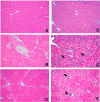Hepatocyte Growth Factor Mediates the Antifibrogenic Action of Ocimum bacilicum Essential Oil against CCl4-Induced Liver Fibrosis in Rats
- PMID: 26213907
- PMCID: PMC6331802
- DOI: 10.3390/molecules200813518
Hepatocyte Growth Factor Mediates the Antifibrogenic Action of Ocimum bacilicum Essential Oil against CCl4-Induced Liver Fibrosis in Rats
Abstract
The current investigation aimed to evaluate the antifibrogenic potential of Ocimum basilicum essential oil (OBE) and further to explore some of its underlying mechanisms. Three groups of rats were used: group I (control), group II (CCl4 model) and group III (OBE-treated) received CCl4 and OBE 2 weeks after the start of CCl4 administration. Oxidative damage was assessed by the measurement of MDA, NO, SOD, CAT, GSH and total antioxidant capacity (TAC). Liver fibrosis was assessed histopathologically by Masson's trichrome staining and α-smooth muscle actin (α-SMA) immunostaining. Expression of hepatocyte growth factor (HGF) and cytochrome P450 (CYP2EI isoform) was estimated using real-time PCR and immunohistochemistry. OBE successfully attenuated liver injury, as shown by histopathology, decreased serum transaminases and improved oxidative status of the liver. Reduced collagen deposition and α-SMA immuopositive cells indicated an abrogation of hepatic stellate cell activation by OBE. Furthermore, OBE was highly effective in stimulating HGF mRNA and protein expression and inhibiting CCl4-induced CYP2E1 down-regulation. The mechanism of antifibrogenic action of OBE is hypothesized to proceed via scavenging free radicals and activating liver regeneration by induction of HGF. These data suggest the use of OBE as a complementary treatment in liver fibrosis.
Keywords: CYP2E1; HGF; Ocimum basilicum; antioxidant; liver fibrosis; α-SMA.
Conflict of interest statement
The authors declare no conflict of interest.
Figures




Similar articles
-
Date fruits inhibit hepatocyte apoptosis and modulate the expression of hepatocyte growth factor, cytochrome P450 2E1 and heme oxygenase-1 in carbon tetrachloride-induced liver fibrosis.Arch Physiol Biochem. 2017 May;123(2):78-92. doi: 10.1080/13813455.2016.1251945. Epub 2016 Dec 14. Arch Physiol Biochem. 2017. PMID: 27960551
-
Antifibrogenic Influence of Mentha piperita L. Essential Oil against CCl4-Induced Liver Fibrosis in Rats.Oxid Med Cell Longev. 2018 Apr 19;2018:4039753. doi: 10.1155/2018/4039753. eCollection 2018. Oxid Med Cell Longev. 2018. PMID: 29849890 Free PMC article.
-
Overexpression of NK2 promotes liver fibrosis in carbon tetrachloride-induced chronic liver injury.Liver Int. 2008 Jan;28(1):126-31. doi: 10.1111/j.1478-3231.2007.01616.x. Epub 2007 Nov 1. Liver Int. 2008. PMID: 17976157
-
[Inhibitory effect of acupuncture on hepatic extracellular matrix production in carbon tetrachloride-induced liver fibrosis rats].Zhen Ci Yan Jiu. 2012 Feb;37(1):8-14. Zhen Ci Yan Jiu. 2012. PMID: 22574562 Chinese.
-
Mistletoe alkaloid fractions alleviates carbon tetrachloride-induced liver fibrosis through inhibition of hepatic stellate cell activation via TGF-β/Smad interference.J Ethnopharmacol. 2014 Dec 2;158 Pt A:230-8. doi: 10.1016/j.jep.2014.10.028. Epub 2014 Oct 24. J Ethnopharmacol. 2014. PMID: 25456431
Cited by
-
Antioxidant and Antiapoptotic Properties of n-Butanol Fraction the Acanthopanax senticosus Extracts in H2O2-RAW264.7 Cells and CCl4-Induced Liver Injury in Mice.Evid Based Complement Alternat Med. 2023 Feb 23;2023:9190198. doi: 10.1155/2023/9190198. eCollection 2023. Evid Based Complement Alternat Med. 2023. PMID: 36874619 Free PMC article.
-
The Potential of Lamiaceae Herbs for Mitigation of Overweight, Obesity, and Fatty Liver: Studies and Perspectives.Molecules. 2022 Aug 8;27(15):5043. doi: 10.3390/molecules27155043. Molecules. 2022. PMID: 35956991 Free PMC article. Review.
-
Hepatic and cardiac implications of increased toxic amyloid-beta serum level in lipopolysaccharide-induced neuroinflammation in rats: new insights into alleviating therapeutic interventions.Inflammopharmacology. 2023 Jun;31(3):1257-1277. doi: 10.1007/s10787-023-01202-3. Epub 2023 Apr 5. Inflammopharmacology. 2023. PMID: 37017850 Free PMC article.
-
Secondary Unconjugated Bile Acids Induce Hepatic Stellate Cell Activation.Int J Mol Sci. 2018 Oct 5;19(10):3043. doi: 10.3390/ijms19103043. Int J Mol Sci. 2018. PMID: 30301191 Free PMC article.
-
Citral-Enriched Fraction of Lemon Essential Oil Mitigates LPS-Induced Hepatocyte Injuries.Biology (Basel). 2023 Dec 17;12(12):1535. doi: 10.3390/biology12121535. Biology (Basel). 2023. PMID: 38132361 Free PMC article.
References
-
- Liedtke C., Luedde T., Sauerbruch T., Scholten D., Streetz K., Tacke F., Tolba R., Trautwein C., Trebicka J., Weiskirchen R. Experimental liver fibrosis research: Update on animal models, legal issues and translational aspects. Fibrogenesis Tissue Repair. 2013;6 doi: 10.1186/1755-1536-6-19. - DOI - PMC - PubMed
MeSH terms
Substances
LinkOut - more resources
Full Text Sources
Other Literature Sources
Medical
Miscellaneous

